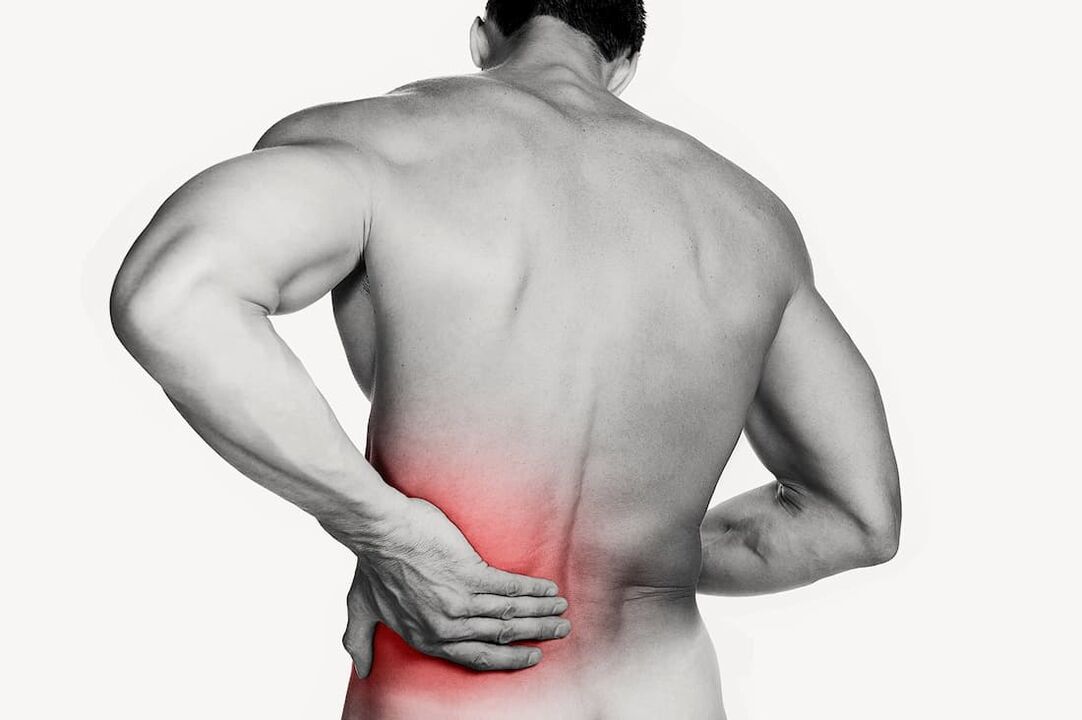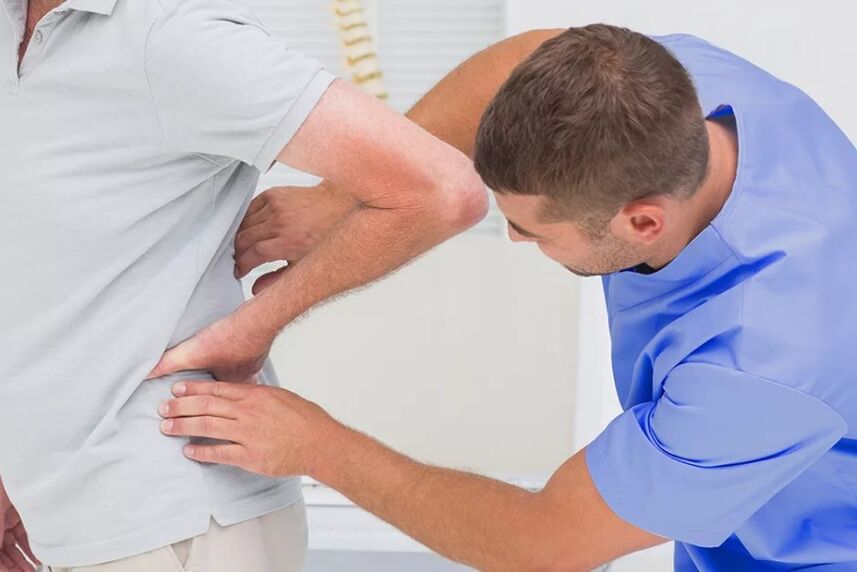
Low pain is rarely paid symptom.Most people do not rush the doctor, lifting it in position, weights or osteocondrosis.In fact, this situation can signal to the kidneys, liver or intestinal diseases, and problems related to the Musaloshelet system will not pass.Only a timely examination of a specialist and a complete exam will help you determine the cause of pain and choose the right treatment.
General information
The lower back is an area experienced in a significant load due to the steep condition.The spinal column is represented by five large vertebres, which is stronger by muscle frame.9 of the 10 pain in this area, 9 in the pathology of the Muskuloskeletal system: Osteocondrosis, muscle spasm, intervertebral disk, the tear, nervous roots.
The remaining 10% are associated with the diseases of the internal organs located in the lower rear projection: kidneys, genitourinia system, bowels, liver.Even when investigating a doctor, he can not always determine the cause of pain, so this situation requires a comprehensive laboratory and instrumental diagnosis.
Types of pain
The first thing to ask the doctor is the nature of the feelings.There may be back pain, depending on the reason why:
- Acute: usually emerges sharply characterized by high intensity;Senses are not more than 1.5 months;
- Subacute: 6-12 weeks last;
- Chronic: any of the feelings of any intensity that lasts 12 weeks or more;
- Transfer (variable): appear periodically;
- Stupid;
- dumb;
- Strong, medium intensity, weak.
This section is conditional.Depending on the situation and conditions, the nature and duration of feelings can change.It is important to describe them as fully as possible.
Reasons
Reasons to start hurting the back in the lower back.Most, provocative factors serve:
- hypothermia;
- Weight lifting;
- Unequal cargo spread (pregnancy, posture disorder, pathology of the musaloshelet system);
- infectious lesion;
- Diseases of the musaloshelet system;
- Inflammatory processes, including autoimmune;
- Remain a long period of time in a concern;
- change in bone tissue (osteoporosis);
- Volume processes: benign and malignant tumors, abscess;
- Hormonal changes (menstruation, pregnancy, menopause);
- Kidney disease (urithiasis, pyelonephritis, glomerulonephritis, abscess);
- Pathology of the gastrointestinal tract;
- The diseases of the uterus and women, prostate in men, etc.Additions.
Diseases
There may be a sign of various diseases of low pain, musaloshelet system and internal organs.The main task of the doctor is to find the situation to deteriorate and take full reason to take the necessary measures.
Here are the most common pathologies.
Ankylosing spondylitis
This is a systemic inflammatory disease with an individual vertebrae in a conglomer.At the same time, calcium deposits in the ligaments that stabilize the spine almost completely lose the mobility of the affected region.
These are different features of the back pain with ankylosing spondylitis:
- Increasing intensity in recreation, especially in a way that extends horizontally;
- Restriction of actions in the Lombber region;
Osteocondrosis of the lomber spine
This is a very common disease, which is delicate of the interim disks, performing the role of shock absorbers.As a result, the nerve roots and cramps of the surrounding muscles are violated by severe pain.In the late stage of the disease, the spinal cord, pressing the pain that increases pain, the intervertible disk emerges.
Pain with osteocondrosis intensifies:
- while lifting in a sedentary or horizontal position;
- While trying to sleep in the stomach;
- With trends.
If the disease causes the formation of a massive tear, the lower rear pain often accompanied with numbness or weakness of both legs.
Lumbar area background (Kyphoz, scoliosis)
In this pathology, pain occurs in the middle and late phase of the development of the disease.Anxiety occurs in general by the end of the day and often accompanied by fatigue of spinal muscles.Pain is more often due to the squeezing of the muscles of the spine and it is possible to investigate the muscles during the disassembly (gluteal, the above-top and lower extremities of the periosemantal muscles).
Spondydydarthrosis
This is the degenerative-doprophic disease of the cartilage covering intervertebral disks.Gradually delicate and destroyed, bone growths (osteophytes) appear around the lesion.As a result of a distance between the vertebra, the narrow, nerve roots and spinal cord of the spinal canal are irritated.
Pain with this pathology:
- strengthens after the load (stay in a position standing in a long-term position, walk) and after rest;
- Accompanied by the stiffness of the actions, the first morning, then permanent;
- It can be transferred to the territory of the Bud and Omba joint.
The muscles in the territory of the lesion are spasmodic and constantly increase, which increases pain.
Urolin's disease
The attack of the Urololaaz is characterized by heavy back pain of affected kidneys.At the same time, the feelings do not change depending on the positive, a person cannot find at least a little weaker.Attacks often change the amount of urine and change to red with a change in color.
Low pain can also be the result:
- AlgoNor (painful menstruation);
- Pregnancy;
- Pancreatic inflammation;
- osteomyelitis;
- intestinal congestion;
- Appendicitis and so on.
Pain in different parts of the back
Localization of pain can say a lot about their reasons.Pain in the upper part of the Lomber area may be a result:
- spinal diseases;
- Injuries;
- muscle spasm in the background of the excessive;
- Cardiovascular diseases;
- tumors;
- Diseases of the gastrointestinal tract.
If the epicenter is in the lower rear, the list of probable reasons, in addition to the infirmasy:
- kidney pathology (pyelonephritis, urolitiasis);
- Intestinal breach (constipation, flatness);
- spasms or inflammatory process in pelvic bodies (saltactoritis, endometer);
- Especially physiological reasons for pregnancy;
- Pinch the sciatic nerve.
Displacement of pain to the right or left, the spinal cord can show the lesion of the corresponding waist of the kidneys.
Diagnosis
Diagnosis of low back pain requires a comprehensive examination.The first stage of looking for the cause is the survey.The doctor clarifies:
- Localization of pain;
- character and duration;
- reasons causing an attack or pain;
- Circumstances in which the situation improves (a certain pose, inactivity, taking medicine, etc.).
Information about injuries and diseases, already determined chronic pathologies are failed.Diagnostic search includes more possible diagnostic search at the doctor's request:
- Blood and Urinary General Test: The inflammatory process in the body helps determine kidney pathology;
- Kidney injury, pancreas, liver and gallbladder, etc.Biochemical blood test to identify signs;
- Ultrasound of the abdominal organs and pelvis, men - prostate gland;
- Ultrasound of kidneys;
- Radiography, CT or Lomber Spine Mri;
- X-chest.
If you have any pathological suspicions after a study diagnosis and inspection, the consultations of more target tests, exams and narrow professionals are determined.Allows you to clarify or refute diagnosis.

Treatment
The treatment of the pain in the lower back depends on its reason.A neurologist, a urologist, a gynecologist and a surgeon can deal with pathology.If we are talking about the diseases of the musaloshelet system, doctors use medical, drugs and drugs and surgical methods to improve the patient's condition.
Drug treatment
The most common tools to relieve Lomber pain are non-intervention anti -inflamational medications (NSAID).They are determined in the form of tablets, intravenous and intramuscular needles, rectal spools, as well as creams, ointments and plasters for local use.The dose of the product, as well as the duration of the course, the duration of the doctor, the uncontrolled use of these drugs can cause unpleasant side effects.
If NSAIDs are ineffective, doctors set hormonal medicines (corticosteroids).They also stop the inflammatory process and help reduce pain.
The third drug group that improves the patient's condition is an antispasmodic.They bring down the muscle cramps down.
In addition, they can be assigned:
- Shredders to reduce edema in a compressed root;
- B vitamins to improve annoying conductivity;
- Sedivers.
The advantage methods
Unrolled treatment completes medication schemes.Depending on the clinical situation, the following may include:
- Physiotherapy procedures (magnetotherapy, laser effect, electrophorehez, etc.);
- Physiotherapy exercise: The progress of trainings is individually prepared in accordance with basic and related diseases;Gymnastics regularly, not only in the office of the clinic, but also at home, there is only an effect in this situation;
- General Strengthening and therapeutic massage (exercised outside of sharpening);
- Acupuncture;
- Help for excellent therapy and osteopath.
Surgery
The doctor, which is based on the general image, reveals one of the indicators of surgical treatment, the surgeon is necessary.The presence of an intervertebral disk is not an indication of surgical treatment, regardless of size.Depending on the instructions, doctors eliminate the intervertebral disk, eliminate the density of spinal cord roots, remove the tumor, etc.The decision to conduct a certain operation is made individually.
Prevention
The most effective way to prevent low low back pain, kidneys, spine and pelvic bodies are to adjust your lifestyle to blaze, but if pain is often created, it should be for an extraordinary application for the specialist:
- Avoid hypothermia;
- To prevent hypodynamia;
- Play sports at an amateur level (swimming is especially useful, affecting the condition of the waist and rear muscles);
- Proper and balanced for meals: Prevent excess nutrition, minimize fat, spicy, excessive dishes;
- excluding alcohol and nicotine;
- Drink at least 1.5 liters of clean water daily without considering tea, coffee or juices;
- Keep the body mass index in a normal level: We no longer affect the condition of the spine and the shortcoming can cause kidney meal.
A person is subjected to the pathology of a person's musalosheletal system, at least twice a year, according to European recommendations for the restoration of pathology of the spine, in accordance with the appointment of the doctor.
























